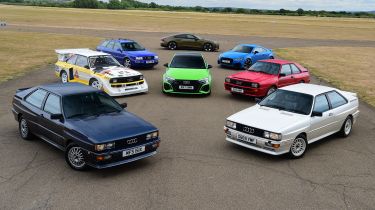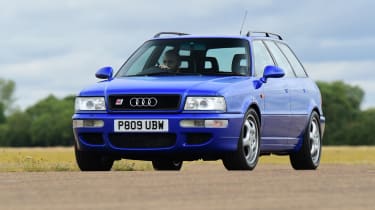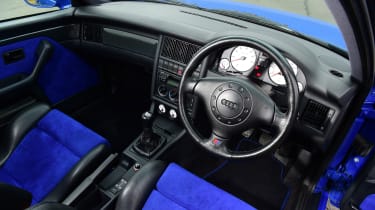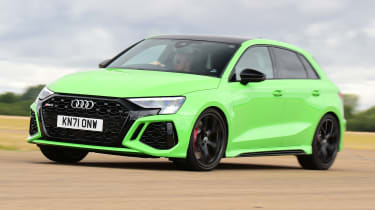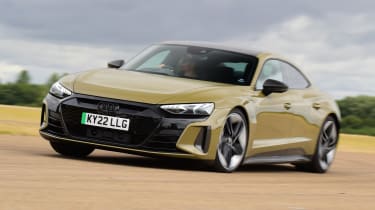Audi RS and performance mega test: historic Audi sports cars head-to-head - RS 2 Avant, TT RS and RS e-tron GT
We drive some of the greatest Audis of all time to see how the brand has developed over the years
Moving from the rally car to the RS 2 Avant could have felt like going from a speed boat to a supertanker, but it really doesn’t. The Avant-only model really kicked off Audi’s fast-estate bloodline in the modern era and was, of course, powered by a five-cylinder engine. The 2.2-litre unit kicked out 310bhp and 409Nm of torque, which in an all-wheel-drive estate car weighing 1,595kg was enough for a 5.4-second 0-62mph time.
Released in 1994, the RS 2 was even claimed to accelerate from 0-30mph faster than a McLaren F1, while carrying a Maclaren pushchair in its boot.
For the Audi RS 2, the German brand teamed up with Porsche for some extra engineering know-how, resulting in that boosted engine output from a bigger turbo, new intercooler and uprated fuel injectors, plus ventilated four-piston brakes taken from the Porsche 968 Club Sport sitting behind 17-inch wheels from the 911 Carrera. On top of all that, the RS 2 benefitted from re-engineered suspension dampers, new anti-roll bars and an electronically locking rear differential as part of the four-wheel drive system, which could also be activated manually by a switch.
Even today, you can still feel these benefits that carved out this machine so distinctly as Audi’s first RS model. It’s easy to see why, nearly two decades ago, and as with the Quattro before it, the RS 2 brought something new to the automotive world. Whereas Audi’s counterparts from BMW M and Mercedes-AMG went for pure rear-wheel-drive layouts, by the brand staying true to its roots and sticking with all-wheel drive, it gave the RS 2 an unburstable character – with some magic from Porsche sprinkled on top of the package to elevate the model’s dynamic ability to new heights for the time.
Used - available now

2020 Peugeot
508
57,957 milesAutomaticDiesel1.5L
Cash £11,999
2021 Ford
Fiesta
9,955 milesAutomaticPetrol1.0L
Cash £16,699
2023 Ford
Puma
18,363 milesAutomaticPetrol1.0L
Cash £16,899
2020 Ford
Kuga
24,644 milesAutomaticDiesel2.0L
Cash £25,799There’s something inherently appealing about fast estate cars, and none more so than the RS 2, which pretty much coined the class. Its Nogaro Blue paint finish is iconic, and from behind the wheel it feels fast, pulling smoothly and with more linearity than you might imagine – certainly compared with its older counterparts.
It’s far sharper than you might expect as well, and while it might not have been a true M3 competitor, it represented a different proposition. Today, it’s deeply cool. The eighties boxiness made way for softer nineties styling, with slightly more curvature to the RS 2’s body quite literally rounding the edge off its estate profile.
It feels special inside, too. The seats are superb – proper, figure-hugging sports items in a genuine family car – while the flashes of blue Alcantara and the white dials (including a row of three at the bottom of the centre console) mean the model’s cabin makeover matched its subtly pumped-up exterior.
From the mid-nineties, there’s a fairly large jump until Audi’s five-cylinder motor appeared again in a pukka performance car – first in the RS version of the second-generation TT in 2009, and then in the RS 3 of 2011. While further iterations of these models have come and gone, the configuration still powers the latest versions of Audi’s hardcore compact coupé and hot hatchback, with both cars likely to be the last that receive the famous five-cylinder unit before it bows out. But what a way to sign off.
The formula of a big, powerful engine in a compact car has long held appeal, and the current TT RS typifies this with a glorious soundtrack, huge performance and all-weather ability, thanks to its Haldex four-wheel-drive system – different from the old-school, traditional quattro set-up, because the engine is mounted transversely in the nose of both the TT RS and RS 3.
While the TT’s precise steering, rock-solid body control (although it gives a slightly fidgety ride) and explosive powertrain mean it still offers something unique going up against 2022’s four-cylinder Alpines and six-cylinder BMWs and Porsches, it’s actually the RS 3 that represents the most technologically advanced fast five-cylinder Audi. The motor plays a big part in that, serving up 395bhp and 500Nm of torque, but the clever RS Torque Splitter clutch pack does just as much for the car’s dynamic ability. Maybe even more.
The common theme running through all of these cars bar for this RS 3 is that, given where those five cylinders were often located within the body, Audi’s engineers often fought physics hard when it came to extracting agility from the brand’s machines.
However, the RS 3’s clever clutch pack can divert all of the available torque sent to the rear axle to just the outside back wheel, creating a much more rear-biased set-up that makes the car near on the most playful fast Audi we’ve ever sampled. Until now, true adjustability hadn’t been part of the playbook, but combined with a clever multi-link rear suspension layout, and much more controlled and forgiving suspension than even an S3, the RS 3 is dynamite. It’s precise and predictable, but it can also be a bit of a hooligan when you want it.
It’s pretty much the perfect car for Britain: small enough to work on our typically narrow roads; supple yet controlled enough to work with – not against – our often torn, broken Tarmac; fast and punchy enough to deliver a serious thrill without needing to achieve stupid speeds to do so; and, now, it has the agility to deliver a quality that’s becoming harder to find in increasingly complicated performance cars – fun.
Make no mistake, the RS 3 still delivers on every five-cylinder check box from the past – noise, pace, visual attitude (especially in our car’s Kyalami Green finish) and a unique approach to performance being just a few – but it adds to this qualities that few Audis before it have possessed. Every single fast machine that follows from the brand won’t possess one facet the RS 3 does, however; the common link between all of the models we’ve lined up here – bar for one – is the engine configuration.
Sadly, the RS 3 is set to be the last car to feature this brilliant motor, and with Audi already embarking on its fully electric future, rapid RS models will be battery-powered and the five-cylinder unit will cease to exist.
Yet it would be remiss not to investigate this future here, and while we’ll mourn the loss of noise and the unique delivery of that turbocharged unit, there are many positives – as the company’s RS e-tron GT shows.
There’s another link to the brand’s past with this most modern of fast Audis; it has been developed in conjunction with Porsche. As with the RS 2, the RS e-tron GT borrows components and engineering expertise from its sister manufacturer. This time, it’s the J1 platform, battery and electric motors that are shared with Porsche, and the Taycan model in particular – and the similarities are obvious from behind the steering wheel, which is very much a positive thing.
With up to 637bhp on overboost from its two electric motors, and a total of 830Nm of torque, the RS e-tron GT’s performance is of the explosive kind. Only the Group B car gets close to the level of clout this 2,276kg luxury electric four-door can deliver, and even then you have to wait for it in the S1 E2. In the 21st century Audi, it’s instant. This is what the electric age offers – and while we do lose in some places, we’ll gain in others.
But even in those areas in which we lose, it might not be by as big a margin as we think, because brands such as Audi are working hard on supporting elements of future packages to still deliver the experience enthusiasts want.
A futuristic five-cylinder soundtrack could well feature in forthcoming hot Audi EVs as a nod to the brand’s heritage, just as elements such as the box wheelarches on the RS 3 reference the original Quattro 40 years later.
What we should celebrate is how Audi has pioneered, nurtured and embraced its unusual five-cylinder engine over the years, and given us four decades of driving fun characterised by a superb soundtrack and stunning performance manifested in some very, very special cars.
Now read our list of the greatest German modern classics...
